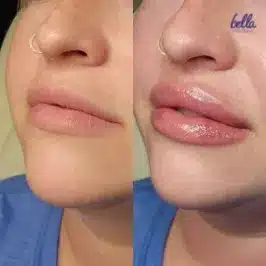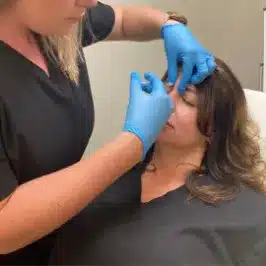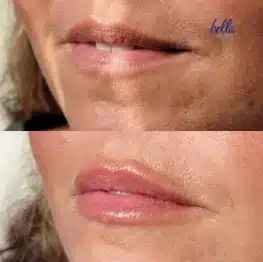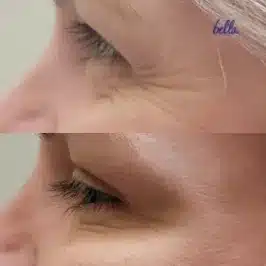Microneedling
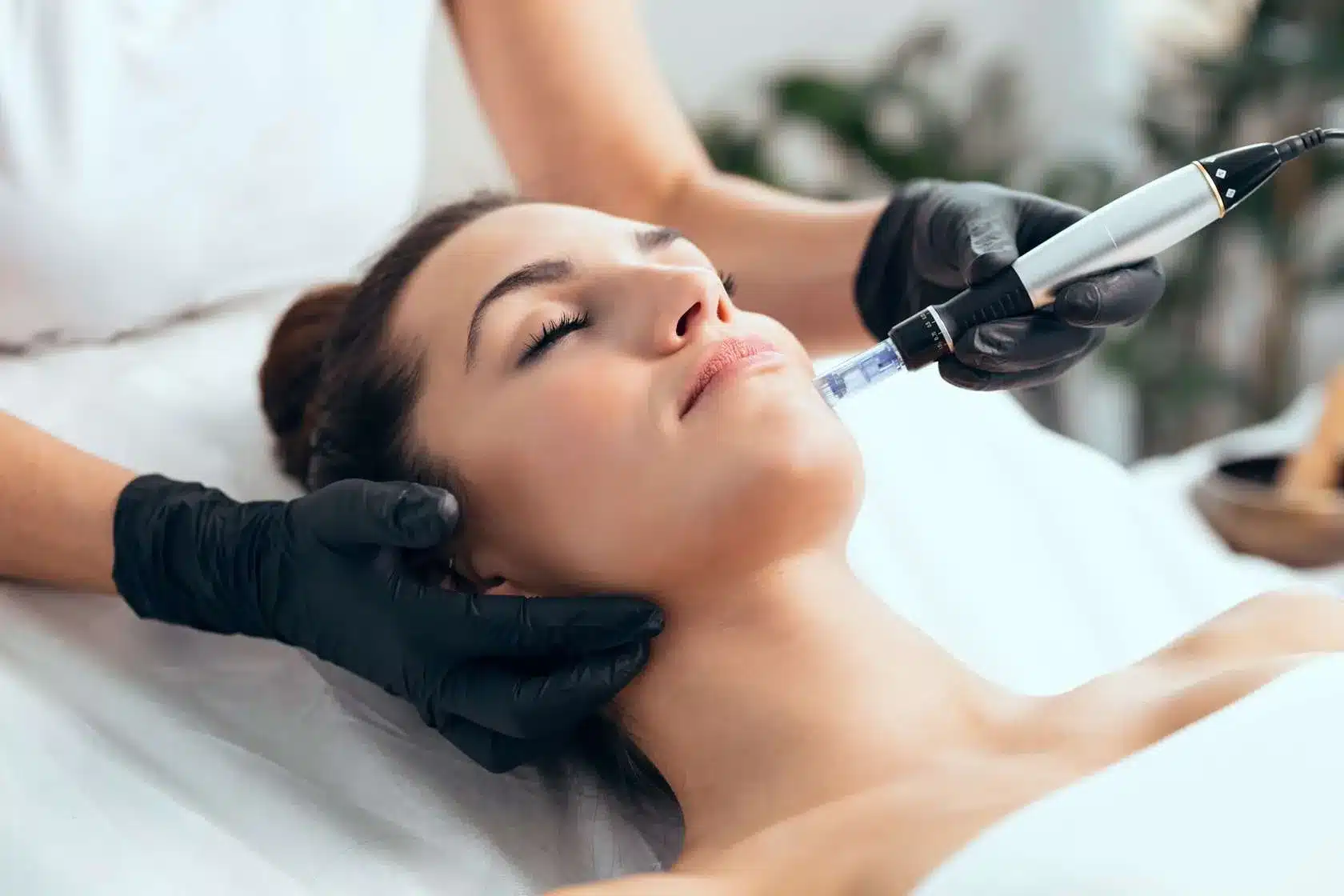
MICRONEEDLING
Appointments available at our offices in Philadelphia on Rittenhouse Square, Newtown (Bucks County), Chester Springs, Harrisburg, Lancaster, PA and Reading.
Microneedling uses tiny sterilized needles to puncture the skin and enact minor physical trauma that prompts deep layers of skin to begin to rebuild themselves. Microneedling is a skin rejuvenation technique used to help treat a range of skin conditions.
Microneedling can help improve a range of skin conditions, including:
- Acne scarring
- Fine lines and wrinkles
- Hyperpigmentation
- “Crepey” skin
- Enhances elasticity and texture of skin
How Does Microneedling Work?
Microneedling traumatizes the skin in order to accelerate its production of collagen. Collagen is a vital protein that keeps skin looking youthful. Aging causes a natural decline in collagen, so a collagen deficiency is one of the primary signs of skin aging.
At a speed of 6,000 stamps per minute, microneedling creates 66,000 micro-holes in the skin, allowing medicinal solutions to penetrate and rejuvenate skin cells. Because the trauma to the skin is minor, it only takes weeks for the skin to heal and display visible results.
Benefits of Microneedling
The primary benefits of microneedling are skin rejuvenation and the re-emergence of a healthy glow lost to aging or skin damage. The treatment stimulates the body’s natural reconstructive response to increase collagen and elastin production, which in turn spurs cell growth and the generation of new, healthy skin cells.
Microneedling is also minimally invasive thanks to the tiny needles used in the procedure. The treatment does not require the general anesthesia or incisions that more invasive cosmetic procedures do. Microneedling carries a significantly lower risk of complications as well.
While procedure times vary based on the size of the treatment area, a microneedling session usually takes about one hour. While you should avoid strenuous activity and sun exposure for a few days afterwards, you can resume other daily activities after your appointment.
Microneedling treatment delivers rapid results. Most patients see visible signs of improvement within a few weeks. This rejuvenation will last for months thanks to your skin’s prolonged protein production.
Beyond its aesthetic benefits, microneedling requires much less downtime and involves significantly milder side effects. Keep reading to learn more about the benefits of microneedling.
Am I a Good Candidate for Microneedling?
Almost any healthy adult is a good candidate for microneedling, with the exception of those with darker skin. Bella Medspa typically treats skin types 1-4.
The treatment is most commonly used to acne scars and scars from injuries. Many individuals also use it to tighten and tone “crepey” or thin skin that they’re experiencing due to natural aging.
If you have wrinkles, fine lines, or a similar skin condition involving signs of aging, the enhanced collagen production induced by microneedling can fill in and smooth those lines and restore your healthy skin texture. It can also address hyperpigmentation stemming from sun damage.
Microneedling is also an option if you want to reduce the size of large pores. Providers can use the procedure to correct skin discoloration and stretch marks.
Consulting a skilled esthetician is the best way to assess whether microneedling is an appropriate treatment option for you. It’s essential to be candid about your aesthetic goals and medical history to ensure the treatment can help you attain your desired results and your provider can rule out any contraindications. Microneedling treatment should always be carried out by a licensed aesthetician such as those at Bella Medspa—never at home.
Who Shouldn’t Get Microneedling Done?
Individuals who have compromised immune systems or who’re undergoing cancer treatment should avoid microneedling due to the elevated infection risk.
While the punctures are tiny, those with blood or clotting conditions should avoid microneedling due to the risk of bleeding. Conditions that cause hard, raised scarring also disqualify individuals from the procedure.
If you’re experiencing severe acne, psoriasis, eczema, or any other serious skin concerns, microneedling is likely unadvisable. Additionally, individuals with moles or skin tags are not good candidates because the microneedles could cause further dermatological damage.
How to Prepare for Microneedling Treatment
The most important step to preparing for your microneedling appointment is to follow the instructions provided by your esthetician. They will offer specific guidelines based on your skin type and the treatment you will undergo.
It’s best to avoid anything that will make your skin more sensitive before your appointment. Tanning, excessive sun exposure, and harsh exfoliants will agitate the skin. These activities can complicate the procedure and extend recovery time.
If you use retinol, isotretinoin, or any other treatments for severe acne, providers will recommend discontinuing that use for up to several days before your treatment. The aesthetician may recommend you stop taking over-the-counter anti-inflammatory medications because inflammation is part of the healing response for microneedling. Be sure to consult your doctor before you stop taking any prescription medication, though.
Generally, it takes three to six microneedling sessions spaced about one month apart to achieve optimal results. Scheduling your treatments ahead of time will enable you to optimize your results and improve your dermatological wellness as much as possible.
What Happens During a Microneedling Session?
The first step of your microneedling session will be to numb the target areas with a topical or local agent. This preparation ensures the procedure is painless. After applying the anesthetic, the provider will wait up to 30 minutes to ensure the area is numb.
Next, they apply a microneedling pen to make tiny punctures to make tiny punctures across the areas with skin damage or wrinkles. This phase of the procedure takes about 30 minutes, depending on the size of the treatment area.
You may feel a slight pressure as the esthetician moves the device across your skin, but you shouldn’t experience any pain. Once the microneedling is complete, the provider will apply a collagen-containing serum to promote healing and soothe the skin in the treatment area.
You will then receive detailed instructions about aftercare and be able to resume your daily routine. It’s critical to ask any questions you may have before leaving.
How Long Do Microneedling Results Last?
The longevity of your microneedling results will depend on your overall health, the extent of your skin damage, and your genetics. The results will last as long as your body keeps producing new collagen.
While your initial results should appear within the first few weeks of your treatment, your appearance will continue improving for up to six months. Many patients then undergo another microneedling session so they can maintain their rejuvenated appearance.
What to Expect After Microneedling Treatment
Immediately after the microneedling appointment, your skin will be irritated and sensitive. Some patients report that their skin feels dry or tight. Others find that it’s red and tender.
We recommend only using mild cleansers, moisturizers, and serums after your treatment. Using sunscreen, avoiding sun exposure, and limiting your use of anything that could irritate your skin is essential to maximizing your microneedling results.
The tiny punctures from the treatment will fully heal by the fifth day of recovery. After that point, you can resume your normal skincare routine and go back to wearing makeup. Still, you should refrain from harsh treatments like chemical peels.
Some people experience peeling and itching as their new skin emerges and replaces the damaged cells. Be sure to avoid scratching or picking at your skin—it could delay the healing process and compromise your results.
In the months after your treatment, your skin will continue to tighten and glow as your enhanced collagen production generates new cells and strengthens the anatomical structures that support your face and skin. Should you experience any unforeseen side effects, don’t hesitate to reach out to your provider.
How Many Treatments Will I Need?
For optimal results, most people require three to six consecutive treatments spaced four to six weeks apart.
Is Microneedling Safe?
Research has shown that microneedling is safe and can help improve skin health as long as professional equipment is used.
The automated vibrating functions of the microneedling pen are safe for users because they prevent unnecessary epidermal damage. Furthermore, the vibrating functions improve the effectiveness of the treatment by increasing the absorption of the skin care products that are used.
Side Effects of Microneedling
While the procedure is minimally invasive, all treatments carry side effects. The most common side effect of microneedling treatment is skin irritation and sensitivity. The punctures are tiny, but they still cause slight damage. As a result, your skin may be red and irritated for up to 48 hours after the procedure. Some people experience skin peeling throughout their recovery.
More significant side effects include bruising, and infection, but such reactions are rare and abnormal. They usually only occur when untrained providers perform microneedling using improper equipment and sterilization practices.
Clinical Research Supporting Microneedling
A number of well-designed clinical studies have demonstrated the effectiveness of microneedling.
- A systematic review published in 2018 concluded that microneedling is both safe and effective for improving skin health (1). The researchers stated that microneedling can rejuvenate the skin and improve the state of scars and wrinkles.
- A press release published by the American Academy of Dermatology stated that microneedling can reduce the appearance of fine lines, wrinkles, scars (2).


